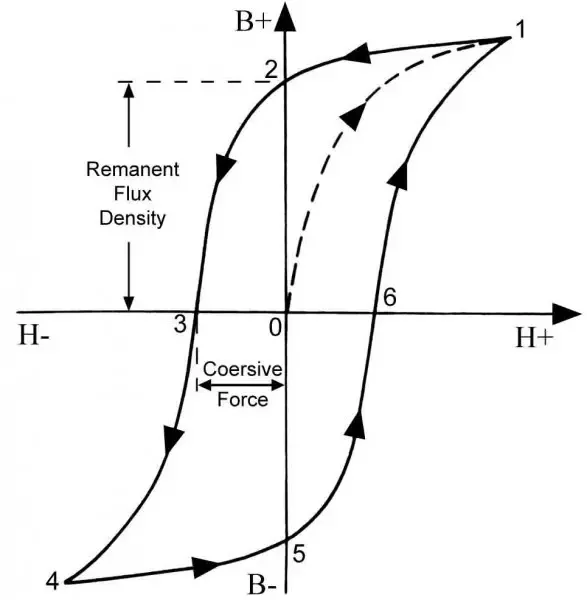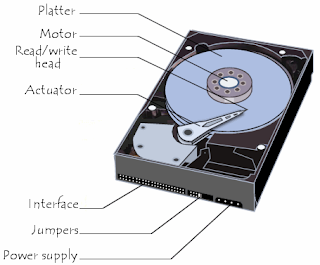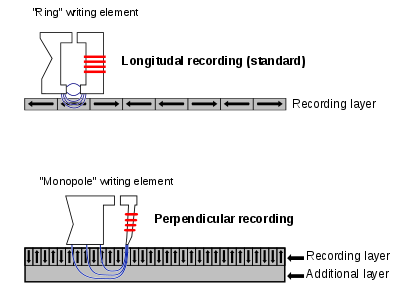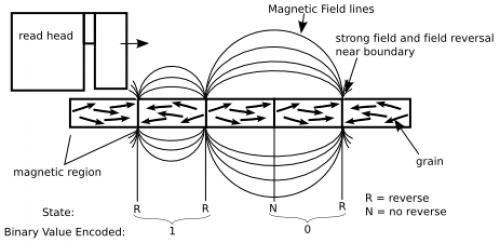The basic workings of Hard Drive Disks (HDD)
The basic workings of Hard Drive Disks (HDD)
Before we can delve into Hard Drive Disks (HDDs) themselves we need to explore some other things first, such as the basics of magnetic materials and how magnetisation can be changed.
The basics about magnetic materials
There are a few magnetic material classifications, such as as diamagnetic, paramagnetic and ferromagnetic. But what is the difference and what is their use case? Materials that fall under diamagnetic are not affected by any magnetic field such as wood. Paramagnetic materials can be seen as materials that temporary hold magnetisation while they are exposed to a magnetic field but when the magnetic fields goes away then the material loses its magnetisation, you can think of aluminium. And ferromagnetic materials keep their magnetic properties after the removal of a magnetic field, an example of this would be iron or Nickel.
But how does a ferromagnetic material retain its magnetic properties? To put it very simple, electrons create a small magnetic field when they “rotate” around the nucleus of an atom but very often those small magnetic fields cancel each other out. But this is not the case with ferromagnetic materials, instead you get a sort of sorting on atomic level (electrons “face” the same direction).
The “magnetic memory” of ferromagnetic materials
In order to explain the following illustration we need to clarify 3 terms: hysteresis which is the “strength” that remembers the magnetic induction, remanence which is the magnetisation that is left behind after removal of the external magnetic field and coercivity which is the point where the "permanent" magnetisation “disappears”.
Ferromagnetics actually can lose their magnetic charge, they are not that pernament. If you have an HDD and you had it stored of several years without turning it on (let's say that it's a backup), then you might have trouble with reading some data. HDD controller periodically "refreshes" magnetical domain/memory cell so data won't fade out.
@jarric
Let’s say we start at a neutral charge (the middle, point 0) and we apply an external positive magnetic force then we would end up in saturation in the right hand top corner, point 1. When we remove the magnetic force we end up in point 2, the point of remanence. If we then apply a negative magnetic force we would first achieve coercivity in point 3 and finally saturation in point 4. When we remove the magnetic force again we will see that point 5 becomes our of remanence. This would give you a basic idea on how a “bit” on a HDD would be changed.
How it is applied
A HDD consists of one or more “platters”, the surface (the ferromagnetic material) where the cells are “stored” on, read/write head(s), a motor which spins the platters around at a constant speed and an actuator which is an arm that moves the heads to position them on the platters. Please note that every head moves together as there is only one actuator.
So as we can see, HDDs use read/write heads that are small magnets which are the external magnetic field from the previous explained techniques.
There are two types of “recording” (or writing), longitudinal magnetic recording (LMR) and perpendicular magnetic recording (PMR). The difference between LMR and PMR is that the “bits” are oriented horizontally for LMR and vertically with PMR (although that is not the only difference, there is also a difference in read/writehead etc). As you can see, perpendicular recording (PMR) would allow for more “surface” to record on compared to LMR but this also has the disadvantage of having a higher point of coercivity. To read the data, the head floats over the surface at a constant speed and detects the changes of the cells.
I hope that this post gave you a basic idea on how a HDD actually works so it is not pure magic anymore for you, if anything was explained badly or confusingly then feel free to leave a comment and I will try to reword it.
Sources
https://www.quora.com/What-is-hysteresis-loss-Where-does-the-loss-actually-occur
http://sunssolution.blogspot.be/2013/02/parts-of-hard-disk-drive.html
https://en.wikipedia.org/wiki/Perpendicular_recording
https://volga.eng.yale.edu/teaching-resources/hard-drives/methods-and-materials
https://en.wikipedia.org/wiki/Magnetic_storage
https://en.wikipedia.org/wiki/Data_degradation#Data_degradation_in_storage (See comments, https://steemit.com/engineering/@thelonelydev/the-basic-workings-of-hard-drive-disks-hdd#@jarric/re-thelonelydev-the-basic-workings-of-hard-drive-disks-hdd-20180221t231235161z)




Ferromagnetics actually can lose their magnetic charge, they are not that pernament. If you have an HDD and you had it stored of several years without turning it on (let's say that it's a backup), then you might have trouble with reading some data. HDD controller periodically "refreshes" magnetical domain/memory cell so data won't fade out.
Source: https://en.wikipedia.org/wiki/Data_degradation#Data_degradation_in_storage
Hi,
Thanks for the heads up! I should not have only put permanent; that was a mistake on my end. I will correct the article & add the source/reference.
Congratulations @thelonelydev! You received a personal award!
Happy Birthday! - You are on the Steem blockchain for 1 year!
Click here to view your Board